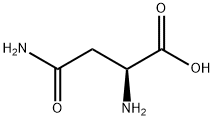L-Asparagine , 98% , 70-47-3
Synonym(s):
(S)-2-Aminosuccinic acid 4-amide;L -Aspartic acid 4-amide
CAS NO.:70-47-3
Empirical Formula: C4H8N2O3
Molecular Weight: 132.12
MDL number: MFCD00064401
EINECS: 200-735-9
| Pack Size | Price | Stock | Quantity |
| 25G | RMB32.00 | In Stock |
|
| 100G | RMB57.60 | In Stock |
|
| 500G | RMB214.40 | In Stock |
|
| 2.5KG | RMB1039.20 | In Stock |
|
| others | Enquire |
PRODUCT Properties
| Melting point: | 235 °C (dec.) (lit.) |
| Boiling point: | 244.01°C (rough estimate) |
| alpha | 34.5 º (c=10, 2N HCl) |
| Density | 1,543g/cm |
| refractive index | 1.4880 (estimate) |
| storage temp. | Keep in dark place,Inert atmosphere,Room temperature |
| solubility | Practically insoluble in methanol, ethanol, ether, benzene. Soluble in acids and alkalies. |
| pka | 2.17(at 20℃) |
| form | Powder |
| color | White |
| Odor | sltly sweet taste |
| PH | 5.41 |
| optical activity | -5.625 (H2O)+28.625 (1 mol dm-3 HCl) |
| Water Solubility | H2O: 20 g/L (20 oC) , clear, colorless |
| Sensitive | Hygroscopic |
| Merck | 14,837 |
| BRN | 1723527 |
| Stability: | Stable, but may be moisture-sensitive. Incompatible with strong oxidizing agents. |
| LogP | -3.820 |
| CAS DataBase Reference | 70-47-3(CAS DataBase Reference) |
| NIST Chemistry Reference | L-Asparagine(70-47-3) |
| EPA Substance Registry System | L-Asparagine (70-47-3) |
Description and Uses
Asparagine (abbreviated as Asn or N) is one of the 20 most common natural amino acids on Earth. It has carboxamide as the sidechain's functional group. It is not an essential amino acid. Its codons are AAU and AAC.
The amino acid L-asparagine is a structural analog of L-aspartic acid, where the side chain of the carboxylic acid moiety is amidated, to give a terminal amine group. This renders L-asparagine neutral at physiological pH. The amide group of asparagine is derived from glutamate, in the reaction of aspartate and glutamine in the presence of ATP to yield asparagine and glutamate. In vivo, asparagine is hydrolyzed to aspartate and NH4+ by asparaginase. Asparagine is also an important amino acid in glycopeptide bonds, via N-glycosyl linkages to the sugar rings.
L-asparagine has been used:
to identify and quantify free amino acids released upon oxidation of proteins and peptides by hydroxyl radicals.
to study the effects of amino acids in promoting food consumption in Drosophila melanogaster.
to study non-enzymatic gluconeogenesis.
L-Asparagine is used in cell culture media and is a component of MEM non-essential amino acids solution.
L-Asparagine has been shown to enhance ornithine decarboxylase activity in cultured human colon adenocarcinoma Caco-2 cells and in cultured IEC-6 intestinal epithelial cells. Spore germination in Bacillus subtilis has been increased in the presence of L-asparagine.
An isoxazoline RGD mimic platelet GPIIb/IIIa antagonist has been prepared by chiral synthesis with L-asparagine as a starting material. L-Asparagine has been utilized in the synthesis of 4-azalysine building blocks for application to combinatorial chemistry.
Safety
| Symbol(GHS) |  GHS07 |
| Signal word | Warning |
| Hazard statements | H315-H319-H335 |
| Precautionary statements | P261-P305+P351+P338 |
| Hazard Codes | Xn |
| Risk Statements | 20/21/22-36/37/38 |
| Safety Statements | 24/25-36-26 |
| RIDADR | UN 2811 6.1 / PGIII |
| WGK Germany | 3 |
| F | 3-10 |
| TSCA | Y |
| HazardClass | IRRITANT |
| HS Code | 29241900 |
| Hazardous Substances Data | 70-47-3(Hazardous Substances Data) |




